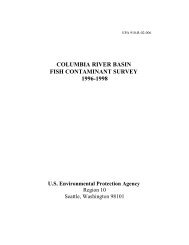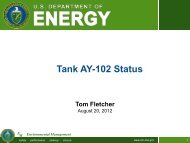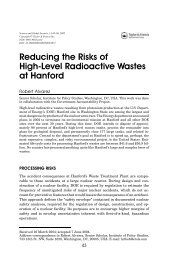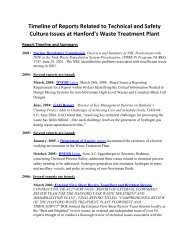Knowing Endangerment - Hanford Challenge
Knowing Endangerment - Hanford Challenge
Knowing Endangerment - Hanford Challenge
You also want an ePaper? Increase the reach of your titles
YUMPU automatically turns print PDFs into web optimized ePapers that Google loves.
Like NASA, <strong>Hanford</strong> has fallen victim to the same production and schedule pressures, the same<br />
complacency, and the same culture of intolerance of dissent. Like the situation with NASA, it is up<br />
to Congress and the Executive Branch to take long overdue action to end the self-serving regulatory<br />
regime that tolerates and even encourages the lack of safety at <strong>Hanford</strong>.<br />
VI.<br />
REMEDIES AND POSSIBLE SOLUTIONS<br />
There is a fundamental conflict of interest inherent in DOE‟s simultaneous role as designer / enforcer<br />
/ beneficiary of “accelerated cleanup” deadlines and as protector of worker health and safety in<br />
meeting those deadlines. Worker health and safety at DOE facilities has been sacrificed for decades<br />
because of this conflict of interest. 166 It is time for Congress to take steps to remove DOE from<br />
oversight of occupational safety and health, since both the DOE and its contractors are incapable of<br />
self-regulation. Truly independent oversight and enforcement of worker health and safety is needed<br />
at <strong>Hanford</strong> and at all DOE facilities.<br />
In the meantime, GAP has several „engineering control‟ recommendations for how to improve the<br />
problem of chemical vapor exposures at the tank farms. Vapor exposures at tank farms can be<br />
significantly reduced or even eliminated by employing some additional safety technologies. A<br />
number of laser or infrared remote chemical detection and analysis technologies have been developed<br />
for detecting hazardous chemicals, radionuclides, and biological weapons. One such instrument has<br />
been tested at the tank farms already. A 1998 <strong>Hanford</strong> Technology Demonstration Fact Sheet 167<br />
reports that an Open Path-Fourier Transform InfraRed (OP-FTIR) instrument was tested in the tank<br />
farms with a Computed Tomography-Remote Optical Sensing of Emissions (CT-ROSE) system<br />
developed by University of Washington researchers. The Fact Sheet indicates that the system can<br />
detect ammonia and 6500 other chemicals at a distance of up to 500 meters, providing an early<br />
warning system to keep workers out of areas with presently venting tanks. Preliminary tests seemed<br />
to indicate that this technology could be used successfully, but for some reason, was not permanently<br />
implemented at the tank farms. DOE should require continued testing and implementation of this<br />
sort of remote chemical analysis and detection technology.<br />
Another device recommended by workers with whom GAP has spoken is a thermal imaging camera,<br />
such as the Scott Thermal Imager II, used by firefighters to see through smoke. The device translates<br />
heat energy (via temperature variations as minute as .007 of a degree) into visual images, which<br />
could assist the IHTs in detecting the point source and plume location of what are normally invisible<br />
chemical vapors. Once the exact location of the vapor is detected, the source could be effectively<br />
sealed or monitored.<br />
Active venting of more tanks on a regular schedule may also help prevent vapor exposures.<br />
Passively vented tanks can potentially emit vapors whenever atmospheric pressure inside the tank is<br />
higher than outside of the tank. If all the tanks were actively vented every few hours or some other<br />
regular, planned time interval, tank farm workers would simply not be scheduled to work in the area<br />
or downwind of the area during the time period where tanks are scheduled to be venting.<br />
166 Multiple expert and government reports have documented pervasive and serious failures in DOE‟s protection of<br />
occupational safety and health. See, Office of Technology Assessment, HAZARDS AHEAD, supra note 161, at 11.<br />
167 At http://www.hanford.gov/techmgmt/factsheets/demos/1998/ftir.html<br />
38







